There is long-standing evidence that in adults a genetic overlap exists in risk between autism spectrum disorder (ASD), schizophrenia, and intellectual disability (
1,
2). A range of recurrent copy number variants (CNVs) in specific loci, and to some extent single-nucleotide variants (SNVs) (
3), appear to be responsible. The biological pathways that are impaired by the associated neurodevelopmental anomalies remain largely unidentified, but it is assumed that these must include neuronal development, synaptic function, and neuronal cell adhesion (
4). Yet, despite the considerable body of research aimed at identifying genetic anomalies that underlie serious neurodevelopmental disorders, relatively little has been written on potential mechanisms underlying diversity in the age at onset of these conditions. Global intellectual disability is usually evident within the first year of life, with a delay in the development of key motor skills such as head control, sitting, crawling, and walking. Evidence that a child is developing ASD often manifests soon after this, with a lack of interest in social communication and, in some cases, with delayed onset of language. The origins of autism are by definition in early childhood, but only a minority of those affected have an underlying intellectual disability, and the trend over time is toward recovery (
5). On the other hand, schizophrenia almost invariably has its onset in late adolescence or adulthood, is exceptionally rare in childhood, and often has a deteriorating course (
6). Studies of adults with schizophrenia have not revealed any consistent pattern of premorbid symptoms, with little evidence of features characteristic of the autism spectrum. Children with autism do not have a substantially increased risk of developing a psychotic disorder in later life. While the polygenic risk factors that underlie risk in both ASD and schizophreniform psychosis, as well as the majority of cases of intellectual disability, could differ substantially, we are still left with the conundrum that rare but specific genetic anomalies are shared between conditions with markedly different periods of clinical manifestation.
Rarely, schizophrenia has an onset in childhood, and is associated with a particularly poor prognosis. Childhood-onset schizophrenia begins under the age of 13 years, and affected individuals possess a greater burden of pathogenic CNVs than is reported in adult-onset cohorts. To date, intensive studies into genetic risk have been seriously limited in scope because of small sample sizes, reducing the confidence with which existing findings can be generalized. Because there are as many children with non-schizophreniform manifestations of early-onset psychosis as there are with strictly defined childhood-onset schizophrenia, Brownstein and colleagues (
7), in a study published in this issue of the
Journal, aimed to investigate genetic risks in a broader category of children, selecting participants who were affected by a wide range of psychotic symptoms that began before the age of 18 years in order to acquire an adequate sample size for their analyses.
The genetic architecture of early-onset psychosis in general is unknown, but previous research has indicated that there is shared genetic risk between ASD and childhood-onset schizophrenia. Accordingly, Brownstein et al. aimed to investigate whether deleterious CNVs (plus some SNVs) that are associated with early-onset psychosis could also be found in children with ASD. This raises challenging questions; if the onset of schizophreniform psychosis is usually in adulthood, and genetic parallels with ASD have been found in those adult-onset conditions, one might anticipate that any specific genetic predisposition to psychosis in early-onset psychosis should differ from ASD. It could also be less strongly associated with intellectual disability; many pathogenic CNVs and SNVs that predispose to ASD also predispose to intellectual disability. The association between intellectual disability and clinical phenotype is not so marked in schizophrenia, as it is in autism, even though there is shared genetic risk. Accordingly, this investigation had the potential to answer the following questions: Are children with early-onset psychosis also impaired intellectually? And are there sex differences in phenotypic expression in this early-onset condition? We know that at the lower end of the IQ distribution in ASD, the sex ratio becomes more equal, but there is substantially greater male identification in those with normal-range intelligence. While there are limited sex differences in the predisposition to schizophrenia, the condition is somewhat more prevalent in men and with an earlier age at onset. If a genetic predisposition is shared between ASD, intellectual disability, and early-onset psychosis, would these shared risks be distributed equally with females if intellectual disability is not a prominent feature of early-onset psychosis?
The focus of Brownstein and colleagues’ study was twofold. First, they studied 40 CNVs and a set of seven genes that had previously been associated with neurodevelopmental or neuropsychiatric disorders. The CNVs were all recurrent loci, previously shown to put carriers at high risk. Potentially, many of the CNVs could have been inherited (
8), but that information is not available. Second, in a novel twist to the investigation, they studied risk that could be attributed to nonrecurrent CNVs too. While recurrent CNVs share a common size and similar breakpoints, nonrecurrent CNVs are defined as structural variants with dissimilar endpoints or junctions. Relative sizes differ between individuals carrying the same nonrecurrent CNV, but they may nevertheless share a small region of overlap. In order to evaluate the pathogenicity of the nonrecurrent CNVs, the authors used a novel measure of genome-wide dosage sensitivity (
9,
10), the CNV risk score (CRS). The CRS reflects the probability of intolerance to haploinsufficiency of each gene encapsulated by every CNV across the genome, regardless of the mutation’s population prevalence. The authors describe this value as being analogous to the polygenic risk score. By these means, they created a CRS pathogenicity score for every individual in the investigation, by summing the potential clinical impact of each individual’s specific range of deletions and duplications.
A total sample of 137 children with early-onset psychosis was recruited, of whom 101 had a psychosis that began before 13 years of age. A sample of this size is a massive achievement for such a rare condition. Of these children with early-onset psychosis, 28% had an onset before age 8, and 28% had a schizophreniform disorder. Thirty-four percent had comorbid ASD, but only 12% of the sample had intellectual disability, which is particularly striking and might reflect an ascertainment bias. There were two relatively large comparison groups, one with ASD (N=5,540) and three pooled unselected community-based cohorts (N=16,504). The investigators found that 8% of the children with early-onset psychosis were recurrent CNV carriers, compared with 3.5% of the ASD comparison group and 1.6% of control group. It was reported recently that in pediatric patients referred for developmental delay, intellectual disability, or ASD, the diagnostic yield of genetic tests can be as high as 30% (
11), but that yield is much lower in autistic children with normal-range IQ. Among the recurrent CNVs (all of which had previously been found to be associated with neurodevelopmental and neuropsychiatric risk) there was enrichment for three mutations—22q11.2 proximal deletion, 16p13.11 deletion, and 1q21.1 duplication. Each had previously been reported in both child-onset schizophrenia and in ASD, as well as in adult-onset schizophrenia. The authors suggest that this finding could provide a clue as to underlying pathobiology, but it is puzzling why similar genetic predispositions can lead to such (predominantly) consistent different ages at onset. It is also notable that these findings were made in a cohort that was not dominated by individuals with significant generalized cognitive deficits, and that the sex ratio was only moderately skewed, with a 2:1 male predominance. The CRS findings for nonrecurrent CNVs were surprising too; in a comparison of CNV risk scores between samples, there was no significant difference between the early-onset psychosis and ASD groups, but both were significantly different from typical comparison subjects in terms of the aggregate impact of both deletions and duplications.
In sum, the authors have conducted a remarkable study that has both conceptual and practical implications. The methodology used to evaluate the aggregate pathogenic impact of recurrent and nonrecurrent CNVs deserves replication. The finding of shared genetic risk between conditions that have such diverse phenotypic manifestations is intriguing and challenges explanation in terms of the mechanisms underlying maturation of biological pathways. And the authors’ recommendation that children with early-onset psychosis deserve genetic screening just as much as those with suspected ASD is clinically relevant and should be heeded immediately.

